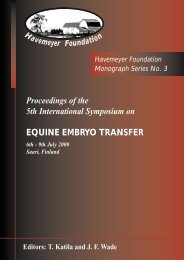Proceedings of a Workshop on - The Havemeyer Foundation
Proceedings of a Workshop on - The Havemeyer Foundation
Proceedings of a Workshop on - The Havemeyer Foundation
You also want an ePaper? Increase the reach of your titles
YUMPU automatically turns print PDFs into web optimized ePapers that Google loves.
Equine Recurrent Laryngeal Neuropathy<br />
abnormal (Grade 3 and 4) laryngeal movement<br />
grades was inaccurate; the inter-relati<strong>on</strong>ship<br />
between pathological changes in the left arytenoid<br />
muscles and the arytenoid movements c<strong>on</strong>sidered<br />
to be indicative <str<strong>on</strong>g>of</str<strong>on</strong>g> these changes is unreliable or<br />
err<strong>on</strong>eous; in young Thoroughbred horses, changes<br />
in grade <str<strong>on</strong>g>of</str<strong>on</strong>g> arytenoid movements frequently occur.<br />
In the present study, 8 <str<strong>on</strong>g>of</str<strong>on</strong>g> 11 <str<strong>on</strong>g>of</str<strong>on</strong>g> the horses changing<br />
from what was c<strong>on</strong>sidered normal laryngeal<br />
movements to abnormal, changed from Grade 1 to<br />
Grade 3. Similarly, <str<strong>on</strong>g>of</str<strong>on</strong>g> those horses changing<br />
laryngeal grade from what was c<strong>on</strong>sidered<br />
abnormal to normal, 10 <str<strong>on</strong>g>of</str<strong>on</strong>g> 14 changed from Grade<br />
3 to Grade 1. Although the results <str<strong>on</strong>g>of</str<strong>on</strong>g> this study will<br />
be affected by the repeatability <str<strong>on</strong>g>of</str<strong>on</strong>g> the endoscopic<br />
procedure used it is unlikely that errors were made<br />
in differentiating Grade 3 laryngeal movements<br />
from Grade 1. Not withstanding the other factors<br />
menti<strong>on</strong>ed, in this age group it appears that: a)<br />
asymmetrical laryngeal movements are comm<strong>on</strong>;<br />
b) laryngeal movements may interchange between<br />
what is c<strong>on</strong>sidered normal and abnormal; c)<br />
development <str<strong>on</strong>g>of</str<strong>on</strong>g> more obvious degrees <str<strong>on</strong>g>of</str<strong>on</strong>g><br />
asynchr<strong>on</strong>y is low (12%); and d) development <str<strong>on</strong>g>of</str<strong>on</strong>g><br />
laryngeal hemiplegia in horses that have<br />
endoscopic evidence <str<strong>on</strong>g>of</str<strong>on</strong>g> deficient left abductor<br />
muscle functi<strong>on</strong> is also low (5%).<br />
RECENT INVESTIGATIONS<br />
More recently, Dix<strong>on</strong> et al. (2002) reported <strong>on</strong><br />
endoscopic and/or clinical progressi<strong>on</strong> <str<strong>on</strong>g>of</str<strong>on</strong>g><br />
recurrent laryngeal neuropathy (RLN) in older<br />
nati<strong>on</strong>al hunt and sport horses (predominantly<br />
Thoroughbred). Fifty-two <str<strong>on</strong>g>of</str<strong>on</strong>g> the 351 horses<br />
examined (15%) showed evidence <str<strong>on</strong>g>of</str<strong>on</strong>g> progressi<strong>on</strong><br />
<str<strong>on</strong>g>of</str<strong>on</strong>g> the degree <str<strong>on</strong>g>of</str<strong>on</strong>g> laryngeal dysfuncti<strong>on</strong> over a<br />
median period <str<strong>on</strong>g>of</str<strong>on</strong>g> 12 m<strong>on</strong>ths (range 1.5–48<br />
m<strong>on</strong>ths) with the <strong>on</strong>set <str<strong>on</strong>g>of</str<strong>on</strong>g> progressi<strong>on</strong> occurring at<br />
median age <str<strong>on</strong>g>of</str<strong>on</strong>g> 7 years.<br />
<strong>The</strong> results <str<strong>on</strong>g>of</str<strong>on</strong>g> this study and the <strong>on</strong>e reported<br />
above (involving predominantly Thoroughbreds)<br />
indicate that the progressi<strong>on</strong> <str<strong>on</strong>g>of</str<strong>on</strong>g> RLN or<br />
alternatively, clinically significant arytenoid<br />
abductor dysfuncti<strong>on</strong>, could vary between 5 and<br />
15%. <strong>The</strong> age <str<strong>on</strong>g>of</str<strong>on</strong>g> <strong>on</strong>set <str<strong>on</strong>g>of</str<strong>on</strong>g> the deteriorati<strong>on</strong> in<br />
arytenoid functi<strong>on</strong> is, however, markedly different.<br />
<strong>The</strong> reas<strong>on</strong> for this is unknown. In additi<strong>on</strong>, Dix<strong>on</strong><br />
et al. (2002) have reported that the time or rate at<br />
which progressi<strong>on</strong> can develop may be as short as<br />
6 weeks. In other cases deteriorati<strong>on</strong> can take<br />
m<strong>on</strong>ths to years. This has important implicati<strong>on</strong>s<br />
for examinati<strong>on</strong> <str<strong>on</strong>g>of</str<strong>on</strong>g> horses for sale and supports the<br />
clinical impressi<strong>on</strong>s <str<strong>on</strong>g>of</str<strong>on</strong>g> veterinarians involved in<br />
sales endoscopy.<br />
In c<strong>on</strong>trast to the above study, Dix<strong>on</strong> et al.<br />
(2002) found no evidence <str<strong>on</strong>g>of</str<strong>on</strong>g> improvement in<br />
laryngeal functi<strong>on</strong> in the clinical cases examined.<br />
In another endoscopic study <str<strong>on</strong>g>of</str<strong>on</strong>g> the laryngeal<br />
movements <str<strong>on</strong>g>of</str<strong>on</strong>g> Thoroughbreds (Lane 2000)<br />
reported <strong>on</strong> the results <str<strong>on</strong>g>of</str<strong>on</strong>g> 2 examinati<strong>on</strong>s<br />
c<strong>on</strong>ducted 12 m<strong>on</strong>ths apart <strong>on</strong> 197 foals. At the<br />
time <str<strong>on</strong>g>of</str<strong>on</strong>g> the sec<strong>on</strong>d examinati<strong>on</strong> 187 yearlings<br />
were available. Video-endoscopic records were<br />
reviewed ‘blindly’ <strong>on</strong> 3 occasi<strong>on</strong>s. <strong>The</strong> results<br />
showed marked inc<strong>on</strong>sistencies in the 2 series.<br />
<strong>The</strong> laryngeal functi<strong>on</strong> <str<strong>on</strong>g>of</str<strong>on</strong>g> some foals appeared to<br />
be within normal limits, but appeared to have<br />
deteriorated over the following 12 m<strong>on</strong>ths.<br />
C<strong>on</strong>versely, 9 foals examined initially were<br />
observed with marked abductor deficiency (Grade<br />
4 <str<strong>on</strong>g>of</str<strong>on</strong>g> 5) but when examined 12 m<strong>on</strong>ths later <strong>on</strong>e<br />
was c<strong>on</strong>sidered normal (Grade 2 <str<strong>on</strong>g>of</str<strong>on</strong>g> 5), 5 were<br />
c<strong>on</strong>sidered equivocal (Grade 3 <str<strong>on</strong>g>of</str<strong>on</strong>g> 5) and 3<br />
remained Grade 4. While it was c<strong>on</strong>cluded that<br />
endoscopy <str<strong>on</strong>g>of</str<strong>on</strong>g> foals is not reliable and decisi<strong>on</strong>s <strong>on</strong><br />
whether to buy or to reject horses should not be<br />
based up<strong>on</strong> this technique, it is possible that some<br />
<str<strong>on</strong>g>of</str<strong>on</strong>g> the variati<strong>on</strong> in laryngeal functi<strong>on</strong> could be the<br />
result <str<strong>on</strong>g>of</str<strong>on</strong>g> successful re-innervati<strong>on</strong> <str<strong>on</strong>g>of</str<strong>on</strong>g> deinnervated<br />
intrinsic laryngeal musculature.<br />
REFERENCES<br />
Anders<strong>on</strong>, B.H., Kannegieter, N.J., Goulden, B.E. (1997)<br />
Endoscopic observati<strong>on</strong>s <strong>on</strong> laryngeal symmetry<br />
and movements in young racing horses. N. Z. vet. J.<br />
45, 188-192.<br />
Baker, G.J. (1983) Laryngeal asynchr<strong>on</strong>y in the horse:<br />
Definiti<strong>on</strong> and significance. In: Equine Exercise<br />
Physiology. Eds: D.H. Snow, S.G.B. Perss<strong>on</strong> and<br />
R.J. Rose RJ., pp 46-50.<br />
Dix<strong>on</strong>, P.M., McGorum, B.C., Railt<strong>on</strong>, D.I., Hawe, C.,<br />
Tremaine, W.H., Pickles, K. and McCann, J. (2002)<br />
Clinical and endoscopic evidence <str<strong>on</strong>g>of</str<strong>on</strong>g> progressi<strong>on</strong> <str<strong>on</strong>g>of</str<strong>on</strong>g><br />
152 cases <str<strong>on</strong>g>of</str<strong>on</strong>g> equine recurrent laryngeal neuropathy<br />
(RLN). Equine vet. J. 34, 29-34.<br />
Lane, J.G. (2000) Limitati<strong>on</strong>s <str<strong>on</strong>g>of</str<strong>on</strong>g> assessment <str<strong>on</strong>g>of</str<strong>on</strong>g> laryngeal<br />
functi<strong>on</strong> in the young Thoroughbred. Proc.<br />
Racehorse Pract. C<strong>on</strong>f. Newmarket, England 22nd-<br />
24th June.<br />
34








